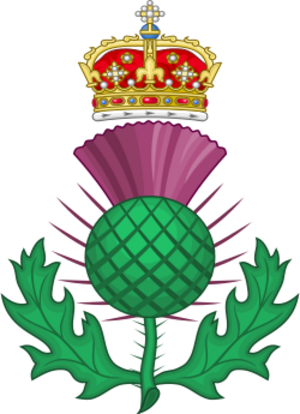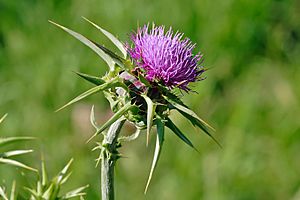Thistle facts for kids
A thistle is a type of flowering plant that has sharp, pointy prickles. These prickles are usually found all over the plant, including on the flowers, stems, and leaves. They act like a natural shield, protecting the plant from animals that might try to eat it.
Thistles belong to a large plant family called Asteraceae. This family also includes other well-known plants like sunflowers and daisies. While many plants are called thistles, the name often refers to specific groups like Carduus, Cirsium, and Onopordum. Sometimes, plants that aren't in these exact groups are also called thistles.
The thistle is a very special plant in Scotland. It is their national flower and a strong symbol of the country.
Contents
Types of Thistles
Many different plants are known as thistles, even though they might belong to various groups within the Asteraceae family. Here are some examples of plants often called thistles:
- Arctium – This is also known as Burdock.
- Carduus – This group includes the Musk Thistle.
- Carlina – Known as Carline Thistle.
- Centaurea – Often called Star Thistle.
- Cirsium – This group includes the Common Thistle and Field Thistle.
- Cnicus – Known as Blessed Thistle.
- Cynara – This group includes Artichokes and Cardoon.
- Echinops – Also called Globethistle.
- Onopordum – This is the Cotton Thistle, also known as the Scots or Scotch Thistle.
- Silybum – This group includes the famous Milk Thistle.
- Sonchus – Known as Sow Thistle.
Some plants from other families are also sometimes called thistles. For example, Salsola is known as Russian Thistle, even though it's in the Amaranthaceae family.
The Thistle as a Scottish Symbol

The thistle has been the national symbol of Scotland for a very long time. It became important during the time of King Alexander III, who ruled from 1249 to 1286. It even appeared on silver coins in 1470, during the reign of King James III.
Today, the thistle is the symbol of the Order of the Thistle. This is a very high honor in Scotland, like a special club for important people. You can see the thistle on many other Scottish symbols. It is also the name of several Scottish football teams. Most Scottish police forces also use the thistle, often with a Scottish crown on top, as their emblem. Even Encyclopædia Britannica, which started in Edinburgh, Scotland, uses the thistle as its symbol.
Why the Thistle Became Scotland's Emblem
There is a famous legend about how the thistle became Scotland's national symbol. Long ago, a Norse army was trying to sneak up on a Scottish army at night. The Norse soldiers were barefoot so they wouldn't make any noise.
However, one Norse soldier accidentally stepped on a sharp thistle. He cried out in pain, which immediately alerted the Scottish soldiers to the invaders' presence. This loud cry saved the Scottish army! Some stories say this happened around the time of the Battle of Largs. This battle marked the beginning of the end for King Haakon IV of Norway's control over Scottish islands.
People still debate which type of thistle was involved in this legend. Many believe it was the Cotton Thistle (Onopordum acanthium) because it looks very grand. However, this plant probably wasn't common in Scotland back then. A more likely candidate is the Spear Thistle (Cirsium vulgare), which grows widely in Scotland. Other thistles like the Dwarf Thistle, Musk Thistle, and Melancholy Thistle have also been suggested.
Historical Uses of Thistle
Throughout history, people believed thistles had various uses, especially in medicine. An old writer named Maud Grieve noted that Pliny, a Roman writer, and medieval writers thought thistles could help hair grow back on bald heads.
In later times, during the early modern period, people believed thistles could cure headaches, fight the plague, heal sores, and help with dizziness or jaundice. These beliefs show how important plants were for medicine in the past.
Images for kids
-
Cirsium arizonicum, showing cobweb-like fuzz on stems and leaves. Ants are often seen with aphids on these plants.
-
Carduus nutans in the early morning light.
-
Thistledown, which helps thistle seeds spread by wind. These tiny seeds are a favorite food for goldfinches and other small birds.
See also
 In Spanish: Cardo para niños
In Spanish: Cardo para niños






